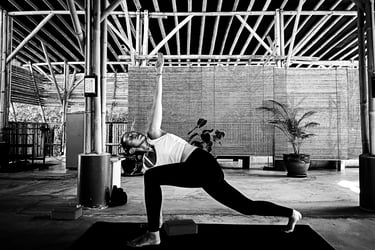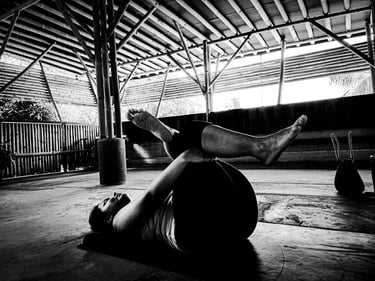Vinyasa Krama
Core Principles of Vinyasa Krama
Breath-Movement Connection : At the heart of Vinyasa Krama is the synchronisation of movement with breath. Breath initiates and informs movement—not the other way around—creating a rhythmic, meditative quality.
Intention and Purpose: Each sequence is shaped by a clear goal—whether it’s spinal extension, hip opening, grounding the nervous system, or preparing for meditation. This gives direction and depth to the practice.
Step-by-Step Progression : Postures unfold in a logical progression, where each prepares the body and mind for the next. This scaffolding respects individual readiness while gradually deepening strength, mobility, and awareness.
Harmony and Balance : Sequences are designed to balance opposites: effort and ease, strength and softness, movement and stillness. This supports both structural integrity and psychological equanimity.
Mindfulness and Presence : Sustained attention to breath, sensation, and internal experience invites deep interoception. The practice becomes not just physical, but profoundly self-reflective.
Adaptation and Modification : Vinyasa Krama honours individual needs. Sequences can be adapted to suit different life stages, health conditions, or physical capacities—without losing their coherence or intent.
By anchoring practice in breath, intention, and step-by-step progression, Vinyasa Krama offers more than just a method for moving through postures. It becomes a structure for cultivating self-understanding, resilience, and transformation—whether you're working with back pain, preparing for childbirth, or simply seeking deeper integration.
What is Vinyasa Krama?
In Sanskrit, vi means “order,” nyasa means “placement,” and krama means “succession” or “steps.” Vinyasa Krama, then, refers to an intelligent, step-by-step progression—often towards a more complex posture or subtle energetic state. It emphasises mindful sequencing of āsanas (postures), guided by the breath.
So, Vinyasa Krama refers to a step-by-step progression towards a specific goal. This approach doesn’t just organise movement. It bridges the gap between body and mind, making each practice intentional, adaptive, and transformative.
Translation notes : Sanskrit terms often carry layered meanings and contextual subtleties that don’t fully map onto single English equivalents.
Vi — “in a special way,” “apart,” “distinctly,” or “orderly”. This prefix implies discernment or specificity—something done with intention or in a particular manner. So vi doesn’t just mean “order” as in “organisation,” but discerned order or purposeful arrangement.
Nyasa — “to place,” “to set down,” “to infuse”. In ritual contexts, nyasa refers to the mental placement of mantras on parts of the body—suggesting an inner, energetic dimension. In movement, it implies placing the body with awareness and care—not just physically, but with subtle intention.
Krama — “step,” “sequence,” “succession,” or “method”. Often translated as “step-by-step progression,” krama also conveys a sense of unfolding with internal logic and purpose. It reflects not just movement through space, but evolution—from gross to subtle, outer to inner, effort to ease.




More Insights
